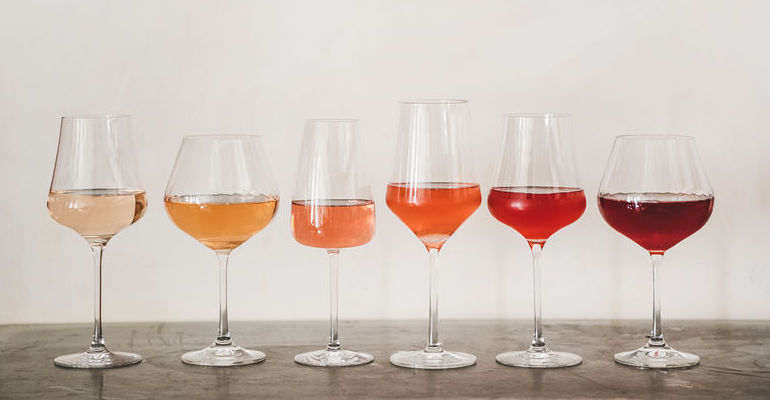What a Rose wine color can tell you
about its flavor
It always amazes me to see so many different Rose wine colors on the shelves, going from very light to dark pink, with sometimes orange hues.
Rose wine colors result from the winemaking process; they are also potential signals on how well or poorly the wine was handled once released.
Can the Rose wine color tell you what wine quality to expect?
I rediscovered this to my disadvantage a few weeks ago.
I was surprised when my husband, Patrick, came back from the market, with three cases of Rose wines. I had indeed asked him to buy our staple wine for the summer but didn't anticipate him to stock up for the whole summer.
Going through the COVID19 pandemic makes us behave differently for sure!
Anthocyanin, the compound responsible for the red/blue color of red fruits, degrade with storage time.
A study published in 2012 [1] showed that 19 months of storage at room temperature caused a reduction of anthocyanin by 50%; it was worse when storage was at a higher temperature (45C). All pigments disappeared!
This study, however, failed to inform us of how storage and temperature affected the wine taste and flavors.
I found some answers in a study published in 2020 [2], investigating how storage time, storage temperature, and light exposure affected the sensory quality of sparkling Rose wines.
Storage temperature and duration impact Rose wine color
An Italian study
After 24 months of aging on lees for the secondary fermentation, bottles were disgorged and allocated to one of these three conditions:
- Storage a 30C in the dark
- Storage at 5C in the dark,
- Storage at 5C under a 9W UV lamp
Researchers sampled bottles from each condition after three months, six months, and nine months.
The analyses consisted of measuring classical oenological parameters, in addition to color, and anthocyanin content. A sensory assessment of the wine quality occurred after nine months of storage.
Their findings
- Under dark conditions, whatever the storage temperature, the color intensity, and hue didn't change for the first six months, compared to the measures taken just after disgorging.
- However, they turned at nine months, with an increase of yellow pigments in the warmer condition, probably resulting from the oxidation of flavonols in yellow pigments. Indeed, the sparkling Rose wines developed a yellow hue.
- The color change was faster and noticeable after three months under UV light exposure. The dark green bottle color didn't stop the damaging effects of the UV light.
Impact on taste and flavors
The sensory quality of the Rose wine stored at 5C seemed the least affected by storage time.
- The effervescence was rapid with small bubbles; the aroma and taste were more intense than in the samples stored in the other conditions.
Storing the wine in the dark and at 30C resulted in the decrease of floral aromas and a noticeable burnt note.
Light exposure under the UV lamp generated off-notes such as wet wool, foxy, and meaty characters, decreasing taste and aroma intensities, and less effervescence.
Off-notes developed during storage under UV lamp
The aromas described above are typical of light strike.
Beer bottled in clear glass bottle are susceptible to light strike, the UV waves degrading some compounds into sulfury notes. This phenomenon also happens in wine, even though dark green bottles were used in the Italian study.
 Image by sevenpixx from pixabay.com
Image by sevenpixx from pixabay.comWet wool or wet dog is a characteristic aroma occurring in wine affected by a light strike. The compounds responsible for this note are sulfur compounds.
 Concord Grapes exhibit Foxy Aromas (WikiComms)
Concord Grapes exhibit Foxy Aromas (WikiComms)Foxy aroma is characteristic of Vitis Labrusca grape, such as Concord grape you can find in the North East of the USA or Canada.
I have always associated foxy with the root beer dominant flavor, which is not my favorite soft drink.
 Image by moritz320 from pixabay.com
Image by moritz320 from pixabay.comThe Burnt aroma can become more perceptible in the light struck Rose wine due to the decrease of the floral and other notes' intensity.
Burnt can be developed in sparkling wines during the aging on lees after the secondary fermentation.
What you want to remember
Storage of Rose wines in the dark is critical, as we learned that constant light exposure degrades the color rapidly, and likely the flavor due to the pigment degradations.
A dark and cool space are the best conditions to preserve the Rose wine color and taste quality. We learned in the Italian study that warmer temperatures decreased the floral notes and increased the burnt character. For sparkling wine, a cooler temperature will help keep the effervescence.
And what about my orangey Rose wine?
Rosé is spelled with an accent on the e. However, in this article, I spelled Rose without the accent to comply with Search Engine Optimization. Sorry about that.
I have sampled several bottles since Patrick bought the three cases.
The first bottle was bland and acidic.
The others had the fruity flavors I expected, with sometimes metallic and burnt notes. The "not so good" bottles went into cooking.
References
[1] Jan Stávek, Barbora Papouskova, Josef Balik & Petr Bednar (2012) Effect of Storage Conditions on Various Parameters of Colour and the Anthocyanin Profile of Rosé Wines, International Journal of Food Properties, 15:5, 1133-1147
[2] Ilaria Benucci. (2020) Impact of post-bottling storage conditions on colour and sensory profile of a rosé sparkling wine. LWT 118, pages 108732.
Published July 29, 2020
Home > How to Choose Wine > Rose Wine Color





New! Comments
Have your say about what you just read! Leave me a comment in the box below.